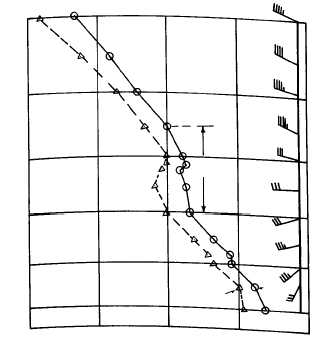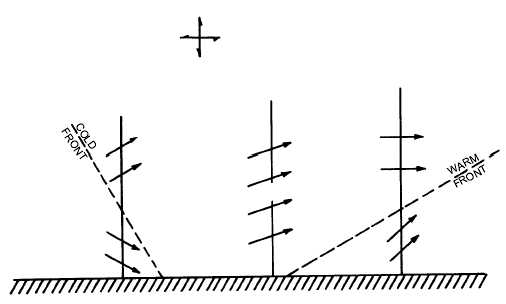From this it can be seen that a front is a wind shift
line and that wind shifts in a cyclonic direction.
Therefore, we can evolve the following rule: if you
stand with your back against the wind in advance of the
front, the wind will shift clockwise as the front passes.
This is true with the passage of all frontal types. Refer
back to figure 4-22.
NOTE: The wind flow associated with the
well-developed frontal system is shown in figure 4-22,
view E. Try to visualize yourself standing ahead of each
type of front depicted as they move from west to east.
The terms backing and veering are often used when
discussing the winds associated with frontal systems.
BACKING.—Backing is a change in wind
direction—counterclockwise
in
the
Northern
Hemisphere
and
clockwise
in
the
Southern
Hemisphere. The opposite of backing is veering.
VEERING.—Veering is a change in wind
direction—clockwise in the Northern Hemisphere,
counterclockwise in the Southern Hemisphere. The
opposite of veering is backing.
The speed of the wind depends upon the pressure
gradient. Look at figure 4-28. In view A, the speed is
about the same in both air masses; in views B and C, a
relatively strong wind is followed by a weaker wind;
and in view D, a weak wind is followed by a strong
wind. An essential characteristic of a frontal zone is a
wind discontinuity through the zone. The wind
normally increases or decreases in speed with height
through a frontal discontinuity. Backing usually occurs
with height through a cold front and veering through a
warm front. The sharpness of the wind discontinuity is
proportional to the temperature contrast across the front
and the pressure field in the vicinity of the front (the
degree of convergence between the two air streams).
With the pressure field constant, the sharpness of the
frontal zone is proportional to the temperature
discontinuity (no temperature discontinuity—no front;
thus, no wind discontinuity). The classical picture of
the variation in wind along the vertical through a frontal
zone is shown in figure 4-29. An example of a frontal
zone and the winds through the frontal zone is shown in
figure 4-30.
4-29
AG5f0429
COLD
AIR
COLDAIR
WARM AIR
N
W
S
E
Figure 4-29.—Vertical distribution of wind direction in the vicinity of frontal surfaces.
AG5f0430
MBS
500
600
700
800
900
1000
-30
-20
-10
0
Td
T
FRONTAL
ZONE
Figure 4-30.—Distribution of wind and temperature through a
warm frontal zone.




